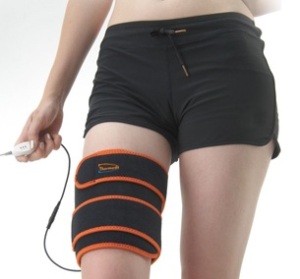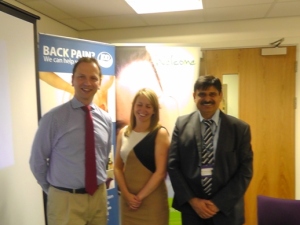Having had my share of hamstring injuries, I know that the biggest pain is not the physical pain, but the pain of not being able to play your sport.
The risk of injury recurrence with any injury is very strong because for the competitive sports man or woman the desire to play can lead to an overwhelming temptation to play again too soon.
This is particularly the case with hamstring injuries and is especially aggravating because good hamstrings are so essential for running (fast!). Incomplete healing, scar tissue, inflexibility and muscle imbalance with the quads mean that recurrent hamstring problems are a common (and expensive) problem.
So, can clinicians do more to help their patients with hamstring injury treatment?
Following the acute injury phase, it goes without saying that good blood flow to the injured site is essential to carry oxygen, nutrients and repair cells for efficient healing. Stretching during the re-modelling phase of healing is essential to ensure that new collagen fibres are laid down neatly.
Evidence shows that applying heat increases the extensibility of hamstrings1 and improves myofascial relaxation2 , thus applying heat before stretching muscles is beneficial. Heat causes vasodilation: a widening of the blood vessels which in turn leads to more blood going through the injured area.
The problem to date has been in finding a comfortable and effective heat application for the hamstrings to help with healing and to help with the return to sport.
 The new Thermedic Thigh is the ideal treatment tool for hamstring injuries. It includes a cold pack to limit bleeding in the injured site whilst the support provides compression during the acute phase.
The new Thermedic Thigh is the ideal treatment tool for hamstring injuries. It includes a cold pack to limit bleeding in the injured site whilst the support provides compression during the acute phase.
But the main benefit for athletes is a unique carbon-fabric FAR infrared heat element which delivers resonant energy into the tissues.
Mains powered, Thermedic has three temperatures and has been show to increase blood flow in tissues and joints; by 204% in the knee and 49% in the abdomen3. The exact amount of increased blood flow in the hamstring hasn’t been measured but we might reasonably assume that the amount be somewhere in between.
At the same time FAR infrared has been shown to increase fibroblast proliferation and collagen regeneration, which are key components of healing4 .
 Another significant benefit of Thermedic FAR infrared over standard heat products is that skin temperatures do not reach burning levels. Thus, it is possible to apply FAR infrared for longer periods meaning that there is a sustained increased flow of blood through the injured site.
Another significant benefit of Thermedic FAR infrared over standard heat products is that skin temperatures do not reach burning levels. Thus, it is possible to apply FAR infrared for longer periods meaning that there is a sustained increased flow of blood through the injured site.
So, rather than 5-10 minutes of superficial warmth, with Thermedic it is possible to increase the blood flow for longer periods for a greater therapeutic effect. This may have interesting implications for angiogenesis in the injured tissues but that question is for a phd student somewhere!
The key thing is to try the Thermedic Thigh on your hamstring and feel the difference compared to ANY other heat application. When you feel this difference yourself, you can appreciate why Thermedic is becoming so popular for hamstring injury rehabilitation and many other painful conditions and injuries.
To order a Thermedic Thigh visit www.Thermedic.co.uk
Author Stephen Small
Director Steadfast Clinics Ltd
www.SteadfastClinics.co.uk
1 D. Funk, A. M. Swank, D. Treolo, K. J. Adams. Efficacy of Moist Heat Pack Application Over Static Stretching on Hamstring Flexibility. Journal of Strength and Conditioning Research, 2001, 15(1), 123–126
2 T. Muraoka, K. Omuro, T. Wakahara, T. Fukunaga, T. Fukunaga, K. Kanosue, Passive mechanical properties of the human muscle-tendon complex at different temperatures. Journal of BiomechanicsVolume 39, Supplement 1 , Pages S197-S198, 2006
3 B.Y. Liau, A. Yang, T.K. Leung, M.C Ou, C.K. Ho and Y.S. Lin. Inhibiting Effects of FAR-Infrared Ray-Emitting Belts on Primary Dysmenorrhea. International Journal of Photoenergy, Volume 2012, Article ID 238468
4 Toyokawa H, Matsui Y, Uhara J, Tsuchiya H, Teshima S, Nakanishi H, Kwon AH, Azuma Y, Nagaoka T, Ogawa T, Kamiyama Y. Promotive effects of far-infrared ray on full-thickness skin wound healing in rats. Exp Biol Med (Maywood). 2003 Jun;228(6):724-9.




